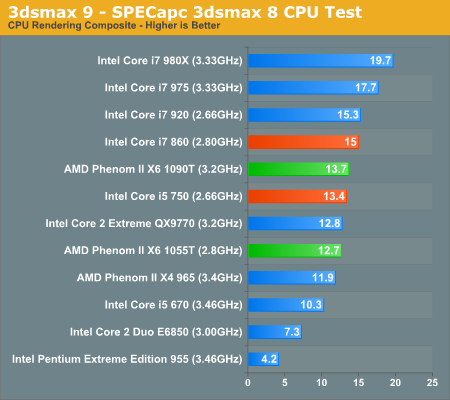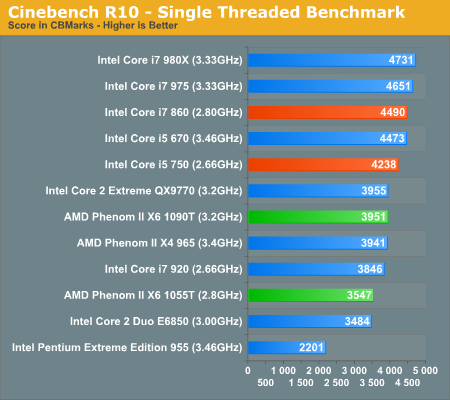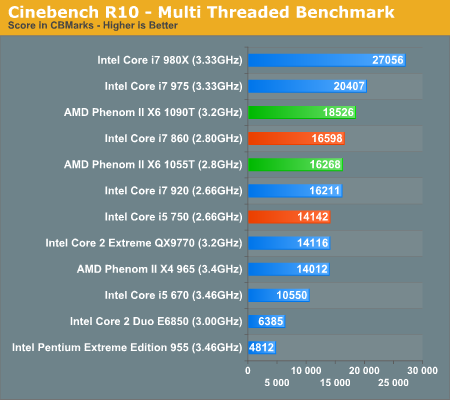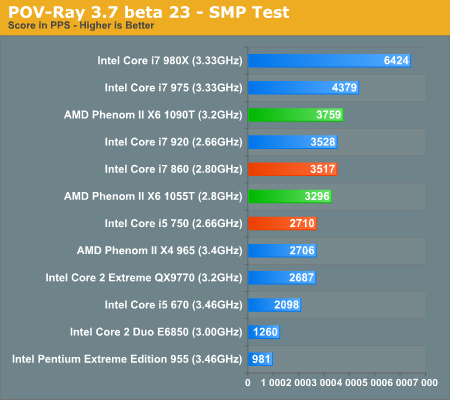AMD's Six-Core Phenom II X6 1090T & 1055T Reviewed
by Anand Lal Shimpi on April 27, 2010 12:26 AM EST- Posted in
- CPUs
- AMD
- Phenom II X6
3dsmax 9 - SPECapc 3dsmax CPU Rendering Test
Today's desktop processors are more than fast enough to do professional level 3D rendering at home. To look at performance under 3dsmax we ran the SPECapc 3dsmax 8 benchmark (only the CPU rendering tests) under 3dsmax 9 SP1. The results reported are the rendering composite scores.
Not all heavily threaded workloads will show the Phenom II X6 in a good light. Here Intel maintains the advantage:

Cinebench R10
Created by the Cinema 4D folks we have Cinebench, a popular 3D rendering benchmark that gives us both single and multi-threaded 3D rendering results.
Single threaded performance is obviously an Intel advantage, but crank up the thread count and there's no match for the Phenom II X6. As we pointed out earlier, if you've got a lot of CPU intensive threads there's no replacement for more cores.


POV-Ray 3.73 beta 23 Ray Tracing Performance
POV-Ray is a popular, open-source raytracing application that also doubles as a great tool to measure CPU floating point performance.
I ran the SMP benchmark in beta 23 of POV-Ray 3.73. The numbers reported are the final score in pixels per second.
Once again, the Phenom II X6 does very well here.











168 Comments
View All Comments
Scali - Wednesday, April 28, 2010 - link
I think people buying an Extreme Edition CPU know exactly what they're getting themselves into.Those CPUs are never good price/performance, you pay a premium to get the absolute fastest CPU on the market, that's the whole point of the Extreme Edition concept.
Obviously Intel isn't going to offer only one expensive 32nm six-core forever. Perhaps this X6 CPU will trigger Intel to release more 'mainstream' six-cores and other 32nm CPUs.
JGabriel - Tuesday, April 27, 2010 - link
For home use, yes. For professional use, that 48.8 frames/second on the 980x vs. 28.5 on the 1090T, for x264 2nd pass encoding, looks quite justifiable. If that's your business, that'll pay for itself in a couple of weeks..
pjconoso - Tuesday, April 27, 2010 - link
Point taken. I was speaking for home users. ;)pow123 - Wednesday, May 5, 2010 - link
Exactly. A few seconds. I will not pay for an over priced processor for a few seconds. Keep it coming AMD.Lolimaster - Tuesday, April 27, 2010 - link
Watch tom's reviewhttp://www.tomshardware.com/reviews/amd-phenom-ii-...
More justice to the AMD cpu's. Just pass the synthetic intel compiler bugged benchmarks.
haplo602 - Tuesday, April 27, 2010 - link
Actualy the results are what I expected and what was also explained in the review. Not stellar, but very good for the money spent ...I guess I'll buy one of the 4-cores.
Hacp - Tuesday, April 27, 2010 - link
Anand, why do you not try to push the chip on overclocking? Also, why not do an I7 overclocked vs Phenom X6 overclocked performance comparison? Overall, I feel that this review was pretty limited and unenthusiastic for such an exciting product.ymetushe - Tuesday, April 27, 2010 - link
Second this. I was really hoping you'd do some overclocked benchmarks, say at 4GHz, so that we could see clock for clock performance of 6 Thuban cores vs. 8 Bloomfield/Lynfield threads.JGabriel - Tuesday, April 27, 2010 - link
Check the x264 and Cinebench results. Clock for clock, at 2.8 Ghz, two hyper-threaded Lynnfield cores seems to match three Thuban cores - at least for rendering & encoding purposes..
Anand Lal Shimpi - Tuesday, April 27, 2010 - link
I try to provide a look at what sort of headroom you can get out of the chip while feeding it as little voltage as possible. The idea is to keep power consumption at a minimum while increasing performance. I found that the jump from 3.8 to 3.9GHz required quite a bit of additional voltage, while just going to 3.8GHz was basically a non-issue - which to me is more impressive than trying to squeeze another 100 - 200MHz out of the chip.Take care,
Anand